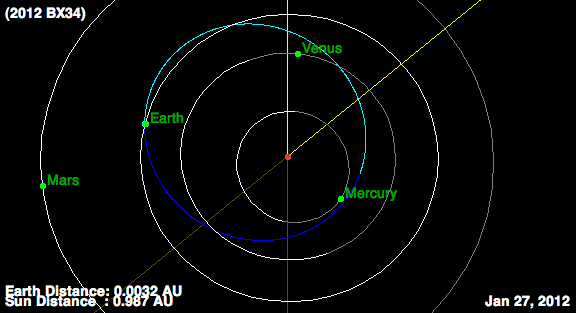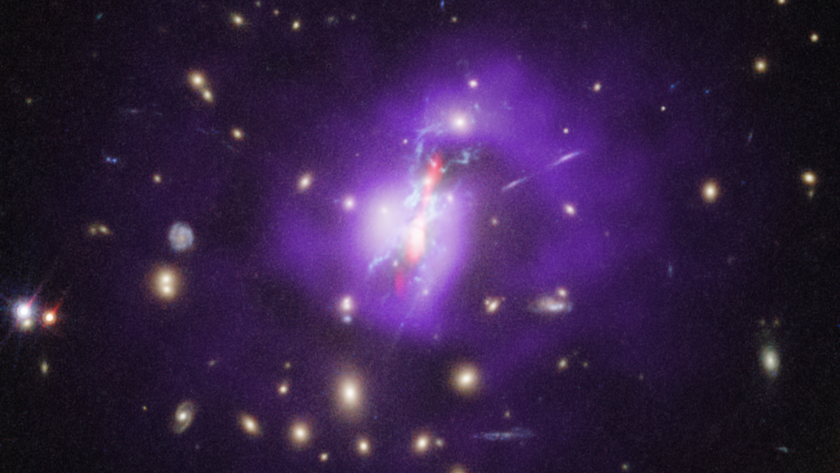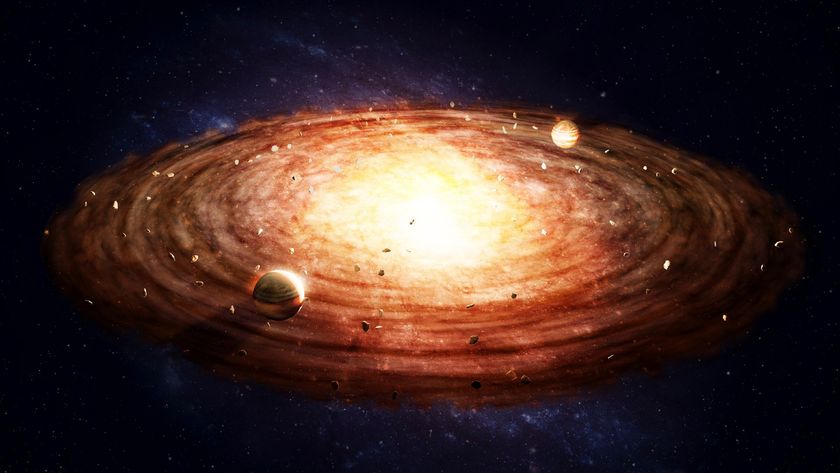
UPDATE: Asteroid 2012 BX34 has safely zipped by Earth. Get the latest news here: Bus-Size Asteroid Buzzes Earth in Close Flyby
A small asteroid will make an extremely close pass by Earth Friday (Jan. 27), coming much nearer than the moon, but the space rock poses no danger of impacting our planet, NASA scientists say.
The newfound asteroid 2012 BX34, which is about the size of a city bus, will pass within 36,750 miles (59,044 kilometers) of Earth at about 10:30 a.m. EST (1530 GMT) Friday, astronomers with NASA's Asteroid Watch program announced via Twitter.
The space rock is about 36 feet (11 meters) wide, making it much too small to pose a threat to Earth.
"It wouldn't get through our atmosphere intact even if it dared to try," Asteroid Watch scientists tweeted today (Jan. 26). Asteroid Watch is based at NASA's Jet Propulsion Laboratory in Pasadena, Calif.
Asteroid 2012 BX34 will zip by at a distance about 0.17 times that separating Earth and the moon. The moon orbits Earth at an average distance of about 240,000 miles (386,000 km). [Video and image of asteroid 2012 BX34's orbit]
While the near-Earth asteroid won't hit Earth, it may offer seasoned amateur astronomers a great show — if they are in the right viewing location and have good equipment.
Get the Space.com Newsletter
Breaking space news, the latest updates on rocket launches, skywatching events and more!
"Advanced amateur astronomers might be able to observe the flyby as the asteroid brightens to 14th magnitude just before closest approach on Friday," the website Spaceweather.com reported today.
In astronomers' classification system, higher magnitudes correspond to dimmer objects. The full moon, for example, has a magnitude around -12.75. A magnitude of +14 would put 2012 BX34 roughly on par with the maximum brightness of the distant dwarf planet Pluto.
NASA scientists and other astronomer teams regularly monitor the skies in search of asteroids that could pose a danger to Earth. Experts estimate that asteroids measuring about 460 feet (140 m) across can cause widespread destruction near their impact sites, but they'd need to be even larger to cause devastation on a global scale.
Last September, NASA announced that it had catalogued about 90 percent of the largest asteroids whose orbits bring them near Earth — a major goal set by Congress in 1998. Using NASA's recent WISE asteroid-mapping mission as a guide, scientists estimate that there are about 981 near-Earth asteroids the size of a mountain or larger. About 911 of those space rocks have been spotted, WISE mission scientists said.
Finding and mapping the orbits of such potentially hazardous space rocks is a task crucial to the long-term survival of our species, many scientists say.
Throughout history, asteroids big enough to cause major damage and disruption to the global economy and society (were they to strike a populated area today) have hit Earth, on average, every 200 or 300 years, according to former astronaut Rusty Schweickart.
Schweickart chairs the B612 Foundation, a group dedicated to predicting and preventing cataclysmic asteroid impacts on Earth. The group's chief message is that humanity's survival will someday depend on our ability to deflect a killer asteroid away from Earth.
The dinosaurs possessed no such technology, of course, and a catastrophic impact wiped them out — along with many other plant and animal species — 65 million years ago.
You can follow SPACE.com senior writer Mike Wall on Twitter: @michaeldwall. Follow SPACE.com for the latest in space science and exploration news on Twitter @Spacedotcom and on Facebook.
Join our Space Forums to keep talking space on the latest missions, night sky and more! And if you have a news tip, correction or comment, let us know at: community@space.com.

Michael Wall is a Senior Space Writer with Space.com and joined the team in 2010. He primarily covers exoplanets, spaceflight and military space, but has been known to dabble in the space art beat. His book about the search for alien life, "Out There," was published on Nov. 13, 2018. Before becoming a science writer, Michael worked as a herpetologist and wildlife biologist. He has a Ph.D. in evolutionary biology from the University of Sydney, Australia, a bachelor's degree from the University of Arizona, and a graduate certificate in science writing from the University of California, Santa Cruz. To find out what his latest project is, you can follow Michael on Twitter.


